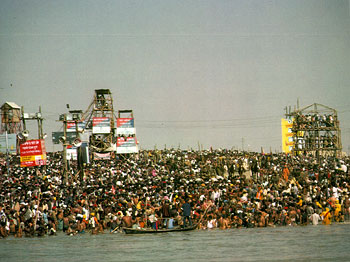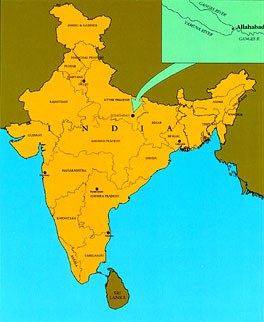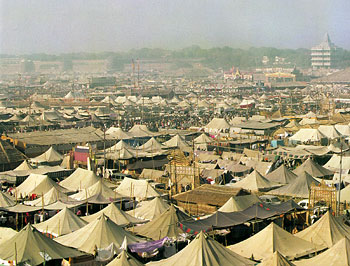






kumbha mela introduction
Festivals have always been an important part of life in India, where a celebration is held for almost every occasion. Some festivals are traditional, like Diwali, the Hindu New Year; some are ceremonial, like Kojagari, the harvest festival; and some are religious, like Rama-vijay, which commemorates Lord Rama's victory over the demon Ravana. All these festivals are held with great pomp and rejoicing. But of all the festivals in India, kumbha mela, the festival held every twelve years at Allahabad, on the bank of the Ganges River, is by far the grandest.
The kumbha mela derives its name from the immortalizing pot of nectar described in India's ancient scriptures. Kumbba in the Sanskrit language means "pot," pitcher," or "jar," and mela means "festival. "
 Kumbha
mela is internationally famous as the earth's largest gathering of human
beings. Throughout the twentieth century, Western civilization has marveled
at the Kumbha Mela. Sensationalistic and inaccurate journalism-reports
of "millions of ignorant people bathing in the filthy water of the Ganges,"
worshiping pagan gods and performing mysterious sacrifices"—has given
the Western world something less than a noble appreciation of the Kumbha
Mela. Thus few Westerners have taken the time to attend a Kumbha Mela
or to understand the esoteric meaning of this poignant event.
Kumbha
mela is internationally famous as the earth's largest gathering of human
beings. Throughout the twentieth century, Western civilization has marveled
at the Kumbha Mela. Sensationalistic and inaccurate journalism-reports
of "millions of ignorant people bathing in the filthy water of the Ganges,"
worshiping pagan gods and performing mysterious sacrifices"—has given
the Western world something less than a noble appreciation of the Kumbha
Mela. Thus few Westerners have taken the time to attend a Kumbha Mela
or to understand the esoteric meaning of this poignant event.
There is something about the Kumbha Mela, however, that captivates the Western mind. Some people say the reaction to the Kumbha Mela is so strong because kumbha mela represents the opposite of Western culture. Others say that the Kumbha Mela beckons the very soul of our existence, calling our higher self to shake off attachments to worldly life and step toward eternity. At any rate, the kumbha mela stirs the thoughts and emotions of most of us.
Kumbha Mela represents all that is India, past and present. One sees represented at the Kumbha Mela all the great spiritual cultures of India. Side by side the ancient traditions stand with a modern, industrialized India with all the latest innovations in television, radio, and computer technology.
I attended my first Kumbha Mela in 1977. At the time I had little knowledge of what the festival was all about. I had heard mixed reports about what to expect at Kumbha Mela: reports about bad sanitation facilities, dirty water, widespread disease, and overcrowded living conditions; stories about hundred-year-old sages; stories about the magical waters of the Ganges; and stories about yogis with mystic power.

![]() My
first impression of the Kumbha Mela as I stood on a high bridge at the
northern end of the festival grounds overlooking an ocean of gray canvas
tents was that it was stunning. There were rows of tents spread in every
direction for as far as the eye could see. Colorful flags and banners
waved gently in the sky. The smell of burning wood pierced my nostrils
as the smoke of thousands of campfires filled the air. Thousands of pilgrims
bathed in the sacred Ganges at sunrise, and dense crowds filled the streets
and thoroughfares.
My
first impression of the Kumbha Mela as I stood on a high bridge at the
northern end of the festival grounds overlooking an ocean of gray canvas
tents was that it was stunning. There were rows of tents spread in every
direction for as far as the eye could see. Colorful flags and banners
waved gently in the sky. The smell of burning wood pierced my nostrils
as the smoke of thousands of campfires filled the air. Thousands of pilgrims
bathed in the sacred Ganges at sunrise, and dense crowds filled the streets
and thoroughfares.
As the days passed, I encountered the wonder and mystery of the Khumbha Mela. There was more to see than I was able to comprehend. For the first time in my life, I experienced a cultural shock: not only was it difficult to adjust to the customs and manners of the Indian people, but I also found myself questioning my own Western values. The very foundation of my conception of life, the reality in which I lived, was shaken at its root. I was forced by circumstance to find a new identity within myself and to adopt a completely new value system. My Western values just weren't enough to deal with the profundity of Kumbha Mela.
What ensued was an unforgettable experience and a true understanding of the Kumbha Mela. I began to understand why millions of people attend the Kumbha Mela, and I began to imbibe an inkling of their faith.
Returning to the West, I found my friends and relatives unreceptive to my experience. Kumbha Mela was foreign to their world. My words weren't enough to paint a substantial picture of Kumbha Mela. I thought of Marco Polo, who in the twelfth century had also traveled to India and like me had had a difficult time communicating his experiences to Westerners.
Trying to describe what people have never seen is difficult. I waited twelve years and returned to the Kumbha Mela. This time I was accompanied by a photographer friend. Equipped with cameras and film, we were determined to bring the Kumbha Mela experience to the West in some tangible form,
We hope our readers will enjoy this book and gain an insight into the deep spiritual meaning of Kumbha Mela, "the largest act of faith."





